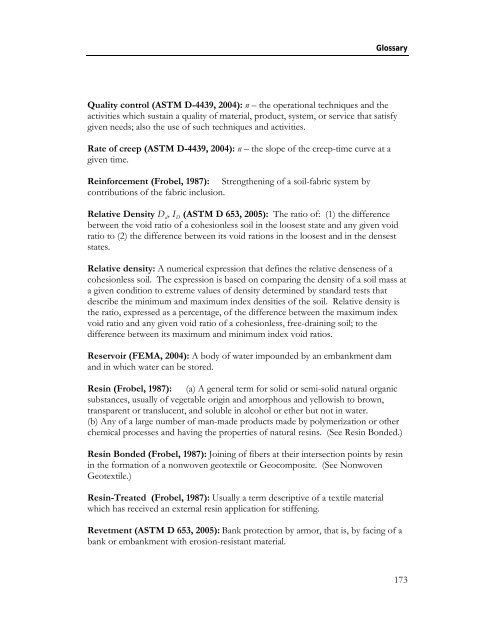Geotextiles in Embankment Dams - Association of State Dam Safety ...
Geotextiles in Embankment Dams - Association of State Dam Safety ...
Geotextiles in Embankment Dams - Association of State Dam Safety ...
Create successful ePaper yourself
Turn your PDF publications into a flip-book with our unique Google optimized e-Paper software.
GlossaryQuality control (ASTM D-4439, 2004): n – the operational techniques and theactivities which susta<strong>in</strong> a quality <strong>of</strong> material, product, system, or service that satisfygiven needs; also the use <strong>of</strong> such techniques and activities.Rate <strong>of</strong> creep (ASTM D-4439, 2004): n – the slope <strong>of</strong> the creep-time curve at agiven time.Re<strong>in</strong>forcement (Frobel, 1987): Strengthen<strong>in</strong>g <strong>of</strong> a soil-fabric system bycontributions <strong>of</strong> the fabric <strong>in</strong>clusion.Relative Density D d , I D (ASTM D 653, 2005): The ratio <strong>of</strong>: (1) the differencebetween the void ratio <strong>of</strong> a cohesionless soil <strong>in</strong> the loosest state and any given voidratio to (2) the difference between its void rations <strong>in</strong> the loosest and <strong>in</strong> the denseststates.Relative density: A numerical expression that def<strong>in</strong>es the relative denseness <strong>of</strong> acohesionless soil. The expression is based on compar<strong>in</strong>g the density <strong>of</strong> a soil mass ata given condition to extreme values <strong>of</strong> density determ<strong>in</strong>ed by standard tests thatdescribe the m<strong>in</strong>imum and maximum <strong>in</strong>dex densities <strong>of</strong> the soil. Relative density isthe ratio, expressed as a percentage, <strong>of</strong> the difference between the maximum <strong>in</strong>dexvoid ratio and any given void ratio <strong>of</strong> a cohesionless, free-dra<strong>in</strong><strong>in</strong>g soil; to thedifference between its maximum and m<strong>in</strong>imum <strong>in</strong>dex void ratios.Reservoir (FEMA, 2004): A body <strong>of</strong> water impounded by an embankment damand <strong>in</strong> which water can be stored.Res<strong>in</strong> (Frobel, 1987): (a) A general term for solid or semi-solid natural organicsubstances, usually <strong>of</strong> vegetable orig<strong>in</strong> and amorphous and yellowish to brown,transparent or translucent, and soluble <strong>in</strong> alcohol or ether but not <strong>in</strong> water.(b) Any <strong>of</strong> a large number <strong>of</strong> man-made products made by polymerization or otherchemical processes and hav<strong>in</strong>g the properties <strong>of</strong> natural res<strong>in</strong>s. (See Res<strong>in</strong> Bonded.)Res<strong>in</strong> Bonded (Frobel, 1987): Jo<strong>in</strong><strong>in</strong>g <strong>of</strong> fibers at their <strong>in</strong>tersection po<strong>in</strong>ts by res<strong>in</strong><strong>in</strong> the formation <strong>of</strong> a nonwoven geotextile or Geocomposite. (See NonwovenGeotextile.)Res<strong>in</strong>-Treated (Frobel, 1987): Usually a term descriptive <strong>of</strong> a textile materialwhich has received an external res<strong>in</strong> application for stiffen<strong>in</strong>g.Revetment (ASTM D 653, 2005): Bank protection by armor, that is, by fac<strong>in</strong>g <strong>of</strong> abank or embankment with erosion-resistant material.173
















